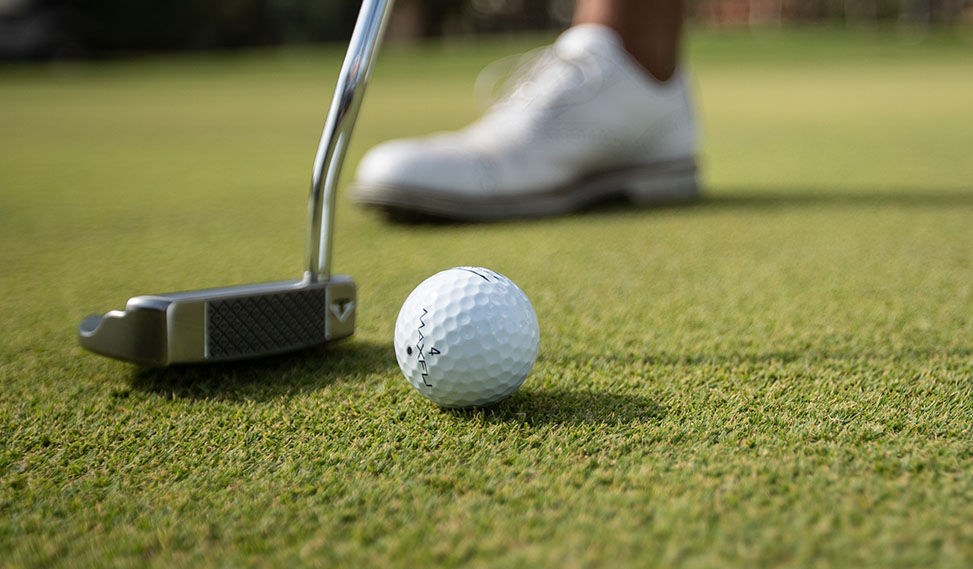
Best New Putters
The most personal club in the bag is the putter. Golfers use it on every hole to pay off a good shot or save their score following a poor one. Having the right tool provides the ultimate confidence to stand over a putt knowing it’s going in the hole. All that remains is to visualize the line and make a solid stroke. Over time, though, the magic can fade.
If you’re looking to jumpstart your game on the greens, we’re here to help. With so many combinations, though, you might need a little patience while finding your new best friend. Are you a blade or mallet player? Face-balanced or toe-hang? Perhaps it’s even time to try a style you’re not as accustomed to. Some putter heads are made from a single piece of metal and others use more materials than the space shuttle. Many heads feature design properties borrowed from full-swing clubs, such as back weighting or a particular center-of-gravity placement, to limit the effect of slight mis-hits. And there are putter faces with firm inserts, others that feel and sound quite soft, and a few that don’t have an insert at all.
Beyond the physical properties, you’ll find models that are built to swing in a variety of ways. That’s because some players prefer a straight-back straight-through stroke while others use an “arc” stroke, where they rotate the clubhead more open or closed. Many putters are also designed to help you align the clubhead correctly and swing the putter with accuracy thanks to visual aids on the clubhead such as lines, dots, even wings or rails.
As you pursue your passion, go ahead and try out different models in the putter corral at a nearby Golf Galaxy store. While there, ask a trained rep to recommend putters that match your stroke. Time to get rolling!
Odyssey Eleven
The Eleven’s multi-material head looks a little like the Starship Enterprise, but the out-of-this-world performance is due to more mass being moved closer to the clubface in the heel and toe. Besides making it easier to square up the face, the weighting improves both directional and distance forgiveness. The updated Stroke Lab shaft (steel tip and graphite near the grip) frees up weight from the center section, and the redistribution of mass to the head and grip sections of the club improve stroke consistency. The company’s beloved White Hot face insert provides softness on short putts and a firmer feel on longer ones. Choose from three topline-alignment options: No markings, single white line, or red-white-and-blue stripes (“Triple Track”). The Eleven family includes toe-hang models for strokes with moderate arc and face rotation, plus face-balanced heads for strokes with little arc or face rotation.

Odyssey Tri Hot 5K
Mallet putters have higher moment of inertia (or “MOI”—in layman’s terms, more forgiveness on off-center hits) than blades. It’s a function of the design. The beauty of Tri-Hot 5K is that it offers more stability and forgiveness than a lot of mallets, plus the nimbleness of a blade. Here’s the secret sauce: The hosel and clubface, made from 303-stainless steel, merge with 120 grams of tungsten in the heel and toe. Plus, the back half of the head is made from lightweight aluminum with two ports in the sole. Players can choose from three sets of weights—tungsten (heaviest), steel (medium) or aluminum (lightest). Swap them at any time in pursuit of a specific feel. Bottom line: There’s plenty of perimeter weighting to go around. The company’s White Hot face insert and Stroke Lab shaft complete the impressive package.

Odyssey White Hot OG
An oldie but goodie has returned. Odyssey debuted the White Hot face insert to great success in 2001, and last year, the company brought back the original two-piece urethane insert as the key ingredient in its White Hot OG collection. Many plastic face inserts can be formulated to feel and sound soft at impact, but this one’s a little different. It can feel firmer but have a soft sound while striking the ball. Familiar head styles included the sleek, classic heel-toe blade (#1), a pair of venerable midsize mallets (Rossie or 2-Ball) and a high-MOI mallet (#7), all in a choice of stepless steel shaft or the Stroke Lab shaft. In 2022, new models include three high-MOI mallets (7CH, 7 Nano or 7 Bird) plus an oversize blade (Double Wide).

TaylorMade Spider GT
The Spider family has gained widespread appeal over the years, and the latest incarnation, Spider GT, is the most stable one to date. Expect off-center hits to be nearly as consistent as dead-center contact with this one thanks to the combination of a lightweight aluminum top plate and heavy wings (there’s a pair of 90-gram steel plugs tucked inside them). All told, the perimeter accounts for a whopping 82-percent of the total head weight.
The GT line also includes three more models: Spider GT Notchback (which has the highest MOI of any midsize-mallet Spider), Spider GT Rollback (a half-moon shape) and Spider GT Splitback (a winged design with high-definition alignment aid). Each model is available in two hosel types—single bend (face balanced) or short slant (toe hang)—so players can select any of the heads, regardless of stroke type.

TaylorMade TP Hydro Blast
Hydro Blasting typically refers to the removal of paint or other debris through the use of a high-pressure stream of water. In this instance, Hydro Blast represents the attractive, high-end putter finish created by the pressurized water stream. But there’s more to these milled, stainless steel heads than meets the eye—for one, the proprietary face insert technology includes grooves. Upon close inspection, the grooves are cut at a downward angle of 45°. What’s the net effect when the ball collides with these grooves? It’s simple: The ball starts rolling with topspin earlier in the putt, which should lead to more consistent, repeatable results. The Hydro Blast series includes a wide selection of blades, mallets, hosels, sightlines and choice of weighting (toe hang or face-balanced).

Scotty Cameron Phantom X 2022
It’s fairly common nowadays to find large mallet putters in both face-balanced and toe-hang designs, but it wasn’t always that way. The original Phantom was one of the first big mallets to be offered with toe-hang weighting, which benefits players who use arcing putting strokes. Prior to Phantom, the high-MOI mallets were available only in face-balanced styles, which complement straight-back, straight-through putting strokes.
For 2022, the Phantom X series includes updates to current models, redesigns and brand-new styles. The body and clubface in each model (except X 12) are milled from a block of stainless steel. In lieu of a face insert, metal is milled out of the sole and replaced with a light aluminum soleplate, which shifts mass to the perimeter. Each model, regardless of size (compact to oversize), has an X-shaped pattern along the sole so it’s easy to set up level to the ground and square to the target.

Scotty Cameron Special Select
For years, the Cameron blades and mid-mallets had “Studio” or “Select” in their name. The addition of “Special” indicates better milling technology, materials and know-how. Each model starts with a block of 303-stainless steel that’s milled to a desired size and shape. The fixed weights along the sole—the blades are fitted with tungsten; the mallets have steel—enhance head stability, making the Special Selecr blades relatively forgiving despite their slim, compact frame. In addition, stainless steel was scooped out of the sole in the midsize-mallet heads and replaced with a light aluminum soleplate to create more perimeter weighting. At address, the tri-level sole provides clear and direct feedback whether the putter is flat on the ground or not.

PING 2021 family
Putter MOI (moment of inertia) has a lot to do with head stability, stroke consistency, distance and control. From standard-size blades to midsize mallets and, naturally, oversize mallets, every model in Ping’s 2021 family is built with significant MOI for its size. How? The company leaned into multi-material constructions featuring steel, tungsten and aluminum. Some models have stainless steel bodies with heavier tungsten or lighter-weight aluminum. Others start with an aluminum body and go from there. The goal is the same: To improve the golfer’s performance regardless of where you strike the ball on the face. The multi-material face insert with shallow grooves delivers soft yet responsive feedback, making the putters appeal to a range of stroke types (straight, slight-arc, strong-arc).
MORE ARTICLES
-

-

Iron Swing Faults and Fixes
-

The Best Ways to Practice Your Driver Swing
-

How to Hit Longer Drives
-

How to Improve Accuracy with Your Driver
-

Iron Swing Fundamentals
-

Driver Swing Fundamentals
-

How to Make Solid Contact with Your Driver
-

The Best Ways to Practice Iron Play
-

Driver Swing Faults and Fixes
-

How to Shape Shots with Your Irons
-

How to Make Solid Contact With Your Irons
-
How to Choose the Best Golf Bag
-
The Best Golf Rangefinders and GPS Devices
-

How to Conquer a Knee Knocker
There are some putts your friends are just not going to concede to you, like a 4-footer for birdie to win your week -

Choosing The Right Putter
When purchasing a new putter, there are some important features to consider. In this video, you’ll learn the differ -

How to Read a Breaking Putt
Do you know where the ball should enter the hole on breaking putts? In this video, you’ll learn how to use time and -

How to Set up for a Putt
All good putts begin with a great setup. Learn how to tell if your putter is too long or too short for you, how far -

Practicing Downhill Putts
For most golfers, it’s unnerving to stand over a fast downhill putt. Learn the adjustments you need to make to the -

How to Read Greens
In order to increase your odds of making a putt, you need to be able to pick the correct line and speed at which th



